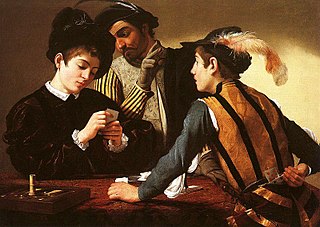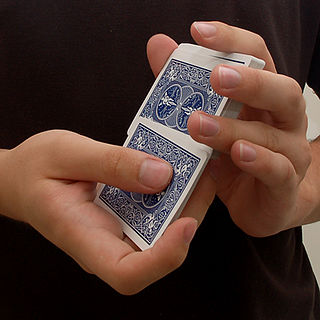
Shuffling is a procedure used to randomize a deck of playing cards to provide an element of chance in card games. Shuffling is often followed by a cut, to help ensure that the shuffler has not manipulated the outcome.

Persi Warren Diaconis is an American mathematician of Greek descent and former professional magician. He is the Mary V. Sunseri Professor of Statistics and Mathematics at Stanford University.
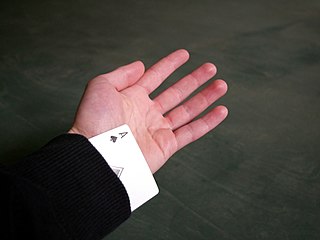
Cheating in poker is any behavior outside the rules that is intended to give an unfair advantage to one or more players.

Card manipulation is the branch of magical illusion that deals with creating effects using sleight of hand techniques involving playing cards. Card manipulation is often used in magical performances, especially in close-up, parlor, and street magic. Some of the most recognized names in this field include Dai Vernon, Tony Slydini, Ed Marlo, S.W. Erdnase, Richard Turner, John Scarne and Ricky Jay. Before becoming world-famous for his escapes, Houdini billed himself as "The King of Cards".
A trick deck usually refers to a deck of playing cards that has been altered in some way to allow magicians to perform certain card tricks where sleight of hand would be too difficult or impractical.

John Scarne was an American magician and author who was particularly adept at playing card manipulation. He became known as an expert on cards and other games, and authored a number of popular books on cards, gambling, and related topics.

Cardistry is a name given to the performance art of card flourishing. The term is a portmanteau of "card" and "artistry". Unlike card magic, cardistry is meant to be visually impressive and appear very hard to execute. People who engage in cardistry are colloquially known as "cardists". Some of the more influential cardists have been Bone Ho, Brian Tudor, Chris Kenner, and Dan and Dave Buck.
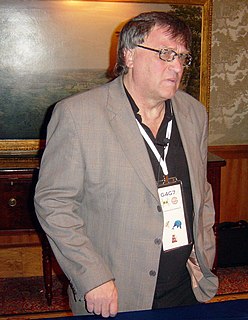
Sven Lennart Green is a Swedish world champion close-up/card magician, a title which he won in 1991 at the FISM convention in Lausanne, Switzerland. He is known for his seemingly chaotic routines which, in spite of first appearances, display great skill. His original techniques and presentation style form an unorthodox and innovative contribution to sleight of hand magic.
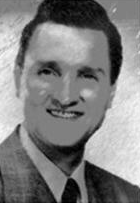
Ed Marlo was a magician who specialized in card magic. He referred to himself and others of his specialty as 'cardicians'.
This is a glossary of conjuring terms used by magicians.
Spelling Bee may refer to one of several card tricks that revolve around the spelling of card types, audience member names, or words suggested by the audience. Many make use of decks prepared in advance in order to provide the illusion of spelling card names in a particular sequence. The Encyclopedia of Card Tricks lists a number of such spelling-based tricks.
A poker dealer distributes cards to players and manages the action at a poker table.
Equivocation is a verbal technique by which a magician gives an audience member an apparently free choice, but frames the next stage of the trick in such a way that each choice has the same end result. For example, the performer may deal two cards to the table and ask a spectator to select one: if the spectator chooses the card on the left, the performer will say something like "you keep this card, I'll take the remaining card". If the spectator chooses the card on the right, the performer will take that card. Thus, the choice of which card to use is really made by the magician.

Close-up magic is magic performed in an intimate setting usually no more than ten feet from one's audience and is usually performed while sitting at a table.
Brother John Charles Hamman S.M. was a close-up magician and Marianist Brother. The tricks he invented are still an integral part of many close-up magician's repertoire. Hamman was world-renowned in the magic community. His initial interest in the art started as a child. As he recuperated from polio, he spent hours learning, practicing and inventing card tricks and other magic involving sleight-of-hand. In many cases, he "reinvented" classic maneuvers or streamlined them. He was a member of the International Brotherhood of Magicians, the Catholic Magicians' Guild and the Society of American Magicians.
Walter Irving Scott was an American musician, cardsharp and amateur magician. His glowing reputation among magicians and card men revolves around his time as a card cheat and a single demonstration of sleight-of-hand to some of the era's best magicians in New York in 1930. He lived out his last years in Rhode Island as a music teacher. Scott spent his formative years perfecting several difficult sleights of card manipulation in order to work as a cardsharp in card games throughout America. He participated in several different types of swindles and hustles. Eventually turning to a music career he was asked to perform one more demonstration. This single event created a legend within the magic community that continues to this day.

The art form of card flourishing, commonly referred to as cardistry, grew out of simple flourishes used in close-up magic by magicians in the 1990s to early 2000s. Chris Kenner's notable two-handed Sybil cut from his 1992 publication Totally Out of Control has carried great influence and gave birth to a series of advanced flourishes which today represents the foundation of the performance art. Sleight of hand pioneers Dan and Dave popularized cardistry on the world stage with their instructional DVD releases from 2004 and 2007. Journalist Kevin Pang of Vanity Fair characterized the art of card flourishing as, "It's yo-yo tricks performed by cardsharps with the street cred of a Parkour video. There's a name for it: cardistry."
